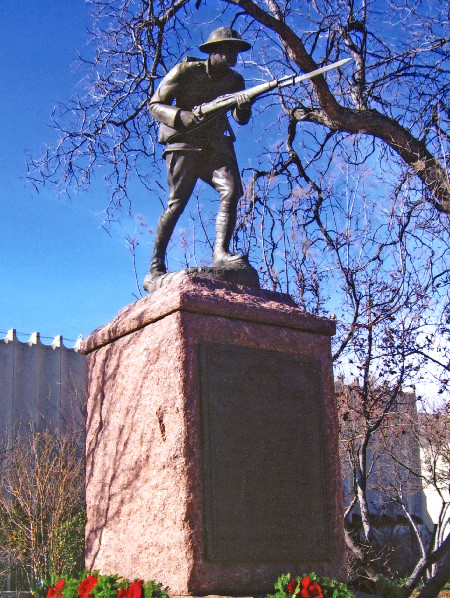

WWI Doughboy (1924) Enid, OK
One of three sculptures attributed to Steven Rebeck in the Art Inventories Catalog of the Smithsonian American Art Museum is a 60 inch high WWI bronze Doughboy on a 72 inch tall granite base in Enid, OK. It was commissioned around 1921 and dedicated July 4th, 1924. (The other two sculptures recorded by the Smithsonian Museum as Rebeck's are the Shakespheare Bust (1916) and Alliance, OH Soldier's Memorial (1924).
Image courtesy of the Enid Chapter Daughters of the American Revolution (DAR), used with permission
The Smithsonian entry at first glance appears confusing - three sculptors are listed: Steven Rebeck, William Ahearn and Pitsiri Tasso. However, the detail is that Tasso replaced the bayonet in 1991 and a July 4, 1974 article in the Enid Daily Eagle Newspaper distinguished that Ahearn was the artist and Rebeck the sculptor.
Because of over at least a dozen Doughboy Statutes by different sculptors and foundries, that the above is Rebeck's is substantiated by its' being the only design among the many in the Smithsonian entries and attributed to Rebeck, the newspaper distinction above and a letter in 1924 from John Harsch Foundry in Cleveland to Enid's Daughters of the American Revolution representative stating their casting was sculpted by Rebeck.
Most recently, "The City of Enid Historic Preservation Commission met January 5, 2012 and reviewed the Doughboy Statue information you provided to us. It was determined the statue is entitled “WWI Doughboy” by Steven Rebeck. This statue was commissioned by the Daughters of the American Revolution and Enid is the only location. The Historic Preservation Commission was excited to learn this statue is one of a kind."
Image used with permission
.taken%20Dec%2013%202008%20%20adj.jpg)
